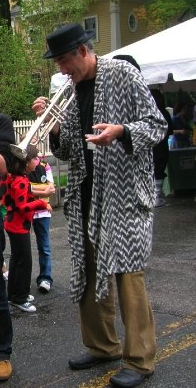Monsieur Proust is welcome to his madeleine. Those little
cakes may have a rich provenance, but they are a rather wan
substitute for more gorgeous desserts (crème puffs, chocolate mousse, etc). That
a madeleine was transmuted by Proust to a “precious essence” can only be
ascribed to a hypochondriac’s aversion to leaving his bed. If Proust had smelled
and tasted the raspberries in my backyard, his prose would not only have risen
to greater heights, he would have been a less dour mec and might even have
moved out of his parents’ house.
But I have come to praise raspberries, not bury Proust.
First of all, each raspberry is unique. We’re told as
children that no two snowflakes are alike, but all snowflakes taste, smell and
look the same-except under a microscope, whereas the variations in size, color,
taste and bouquet of raspberries are infinite.
Light pink when emerging, the fruit grows deeper in color, changing
over the course of two weeks or so to a deep purple-red. Although a raspberry
may be perfectly formed, don’t pick the fruit too early in the cycle. The
bouquet is not developed and the taste somehow both flaccid and acrid. As the
color deepens the taste and bouquet emerge.
Oenophiles speak of a wine’s “nose” and “body.” The word
“raspberry” comes from a mid-15th century word raspise--"a sweet
rose-colored wine" and all the complexities imputed to vintages from the Haut-Médoc
may be found in this fruit. The bouquet and taste intertwine to create an
experience that is pungent and regal; delicate and insouciant; subtle and
stentorian.
A raspberry should be eaten in its natural state. Sugar and
pectin are no friend to the raspberry, which does not translate well to jelly,
preserves, even tarts. Freeze them if you must, but like a person with titanium
implants who must respond to excess humidity, they will never be quite the
same.
Unlike blackberries, when you pick a raspberry, it will come
to your fingers without the central torus: hollow; with nothing pulpy to
detract from the taste. When fully matured, the surface texture is pure velvet.
A raspberry should yield slightly to the touch, but the tiny sections must cohere.
Breeds of raspberries other than my own have many fine qualities, but tend to
crumble in the hand, and no matter how quickly you shovel the pieces into your
mouth, the experience will be disjointed, like listening to a stereo record
through one speaker.
While Proust’s madeleines transported him to les temps
perdue, eating raspberries anchors me in the present. It is one of the things
in my life that effectively brings me here now. My bushes have yielded fruit
annually for the last 20 years, making mid-July glorious even when the weather
is not. I have done very little to help my raspberries prosper. Every spring, I
cull the dead shoots; no fertilizer, no special watering or weeding.
With apologies to Matthew 6:28-33: Consider the
raspberries of the field, how they grow; they neither toil nor spin; yet I tell
you, even Solomon in all his glory was not arrayed like one of these.




